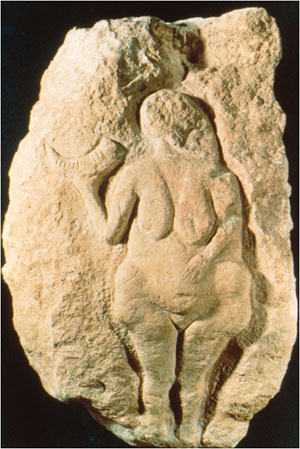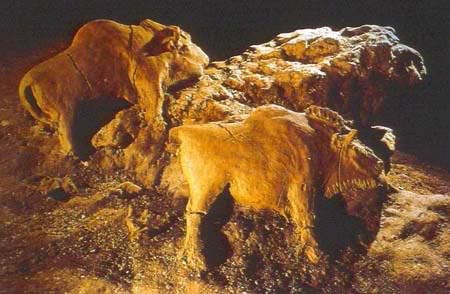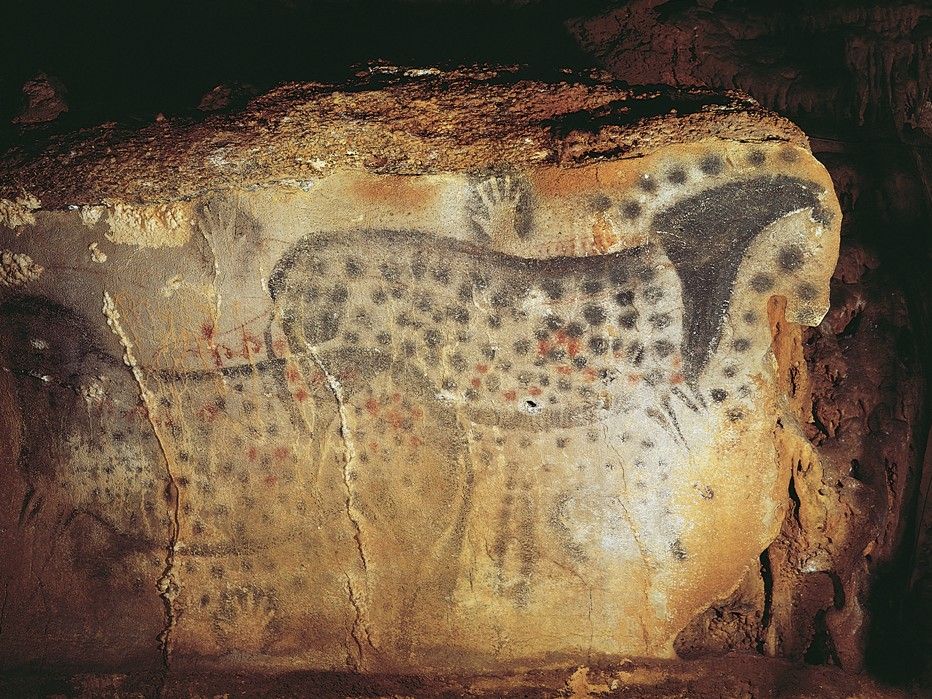Cards In This Set
| Front | Back |
 |
-Venus of Willendorf (Willendorf, Austria)-Limestone-4 1/4" (fits in your hand)
-"Paleolithic" (28,000-25,000 BC)-Typical Paleolithic representation of women, whose child-bearing capabilities ensured the survival of the species. |
|
"Paleolithic"
|
From the Greek paleo - "old"; lithos - "stone"Old Stone Age, during which humankind produced the first art objects beginning 30,000 BC*Humankind went beyond the recognition of human and animal forms to the representation of them.
|
 Prehistoric sites in Europe |
Willendorf (Austria)Laussel & Lascaux (France)Salisbury Plain, England
|
 |
-Woman holding a bison horn(Laussel, France)
-Limestone-18" high-Paleolithic (25,000 - 20,000 BC)One of the oldest relief sculptures. |
|
"Relief"
|
In sculpture, figures projecting from a background of which they are part of. The degree of relief is designated high, low (bas), and sunken (hollow).example: Woman holding a bison horn
|
 |
-Two bison(France)-Clay-2' long-Paleolithic (15,000 - 10,000 BC)-Modeled in clay (with hands/tools) against rock as opposed to cutting into rock surface.
|
 |
-Spotted horses and negative hand imprints(France)-Wall painting-11' 2" long-Paleolithic (22,000 BC)Hand-prints (signature) were negative meaning pigment was blown over the hand. The horse on the right may have been inspired by the rock formation.
|
 |
-Hall of the Bulls(Lascaux, France)-Wall painting-11' 6" long-Paleolithic (15,000 - 13,000 BC)-Many of the animals are colored silhouettes, but others were created by outline alone (the two basic approaches to painting in the history of art.)
|
|
"Composite view"
|
(Also know as "twisted perspective")A convention of representation in which part of a figure is shown in profile and another part is shown frontally; it is a descriptive, as opposed to a strictly optical, method of representation. example: The bull in the Hall of the Bulls
|
 |
-Rhinoceros, wounded man, and bison(Lascaux, France)-wall painting-3' 8" long-Paleolithic (15,000 - 13,000 BC)-First example of a narrative. One of the first where man (as opposed to woman) is depicted.
|
|
|
-Great Stone Tower(Jericho)-28' high-Neolithic (8,000 - 7,000 BC)-First known stone fortifications-Building/society...pop 2,000-Monumental stone structures were common among Neolithic period
|
|
|
-Landscape with volcanic eruption(Catal Hoyuk, Anatolia...now Turkey)-watercolor copy of a wall painting-Neolithic (6150 BC)-Represents Catal Hoyuk.-Geographical narrative...first true landscape painting (no humans or animals appear) Mt Hasan (volcano) in background
|
|
|
-Stonehenge(Salisbury, England)-97' in diameter-Neolithic (2550 - 1600 BC)-Megalithic monument-Solar calendar
|
|
"Megalith"
|
Literally, "great stone"' a large, rougly hewn stone used in the construction of monumental prehistoric structures.ex: Stonehenge
|
|
"Cromlech"
|
An arrangement of huge stones in a circle; also called a henge.
|



